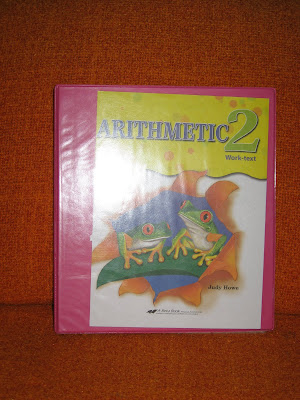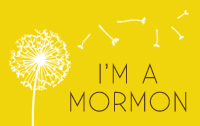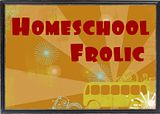 One of my readers asked me what all was in Miriam's cubicle. I thought I'd answer that question today.
One of my readers asked me what all was in Miriam's cubicle. I thought I'd answer that question today.Notice the pink "math" binder. It is a compilation of three resource books. I take the pages out, put them in page protectors so I can reuse the resources with my other children, and mix them up so Miriam isn't doing the same types of math problems every single day.
This year, in her math binder, is A Beka Arithmetic 2. I used only A Beka last year and Miriam quickly became bored and unhappy with math. A Beka is very repetitious. Good practice, but boring. So, I am using A Beka again this year, but we don't try to do everything. We skip everything that Miriam already knows how to do and only do a few of the practice problems. That way, I have more practice available if Miriam needs it, but we aren't boring her adorable red head.
Later, I'll show you the other two resources. Sorry, ordering pictures in blogger is a skill that I can never seem to master.

 Language Lessons for the Very Young is fantastic. I love it. My children love it. This year, however, I've noticed that Miriam needs a little bit more depth for some subjects. For example, Language Lessons introduced capital letters, but Miriam needed more practice. I printed off some worksheets from free sites on the internet, she filled them out, and we moved on. Sometimes I think Language Lessons gets in-depth enough for this stage, and other times I supplement. But we'll stick with this program for awhile because we all love the pictures and narration. If you want to read more about Language Lessons for the Very Young you can read my in-depth review.
Language Lessons for the Very Young is fantastic. I love it. My children love it. This year, however, I've noticed that Miriam needs a little bit more depth for some subjects. For example, Language Lessons introduced capital letters, but Miriam needed more practice. I printed off some worksheets from free sites on the internet, she filled them out, and we moved on. Sometimes I think Language Lessons gets in-depth enough for this stage, and other times I supplement. But we'll stick with this program for awhile because we all love the pictures and narration. If you want to read more about Language Lessons for the Very Young you can read my in-depth review. My kids all have a "fancy" drawing book. We use it when we try to draw or paint "masterpieces" (meaning we try to copy a great work of art), or when we use watercolor pencils or anything like that. My children love it when I pull out the "fancy" art stuff.
My kids all have a "fancy" drawing book. We use it when we try to draw or paint "masterpieces" (meaning we try to copy a great work of art), or when we use watercolor pencils or anything like that. My children love it when I pull out the "fancy" art stuff. Some people don't care about teaching their children how to take multiple choice tests. I think that is a severely problematic stance. Even if your student never takes a test inside a k-12 classroom, that student will still need to take the ACT or SAT. Once in college, students take countless tests of this nature. If they haven't learned all the best test-taking strategies, they will be at a disadvantage. It is best to teach test-taking. I like Spectrum. I'm sure there are a lot of other good programs.
Some people don't care about teaching their children how to take multiple choice tests. I think that is a severely problematic stance. Even if your student never takes a test inside a k-12 classroom, that student will still need to take the ACT or SAT. Once in college, students take countless tests of this nature. If they haven't learned all the best test-taking strategies, they will be at a disadvantage. It is best to teach test-taking. I like Spectrum. I'm sure there are a lot of other good programs. My dad does a lot of textbook adoption reviews, so I get a lot of free stuff. This reading and writing practice book is one of those free items. I only pull it out every once in awhile. It has short stories/essays, followed by fill-in-the-blank comprehension questions. A little boring, but good practice.
My dad does a lot of textbook adoption reviews, so I get a lot of free stuff. This reading and writing practice book is one of those free items. I only pull it out every once in awhile. It has short stories/essays, followed by fill-in-the-blank comprehension questions. A little boring, but good practice. Miriam hates to write. I think it is a combination of two things: 1) she likes to do everything perfectly, and she doesn't know how to spell all the words she knows; and 2) she can't write as fast as she can think. Whatever the reasons--her handwriting is atrocious and she avoids writing whenever possible. I'm thinking seriously of getting the Handwriting Without Tears series for her. For right now, I make her fill out one page of this Disney Diary every day. I bought the book at DI and it is out-of-print (I checked at amazon for you), but it has certainly come in handy at our house. Each page describes something about one of the princesses and then asks the reader to write about something similar. For example, Beauty lived in a cottage and then a castle. Where do you live? Miriam hasn't complained about it much because I save it for last and she knows as soon as she's done it is free time, and because it involves princesses.
Miriam hates to write. I think it is a combination of two things: 1) she likes to do everything perfectly, and she doesn't know how to spell all the words she knows; and 2) she can't write as fast as she can think. Whatever the reasons--her handwriting is atrocious and she avoids writing whenever possible. I'm thinking seriously of getting the Handwriting Without Tears series for her. For right now, I make her fill out one page of this Disney Diary every day. I bought the book at DI and it is out-of-print (I checked at amazon for you), but it has certainly come in handy at our house. Each page describes something about one of the princesses and then asks the reader to write about something similar. For example, Beauty lived in a cottage and then a castle. Where do you live? Miriam hasn't complained about it much because I save it for last and she knows as soon as she's done it is free time, and because it involves princesses.The Reading for Information series I also got from my dad. I LOVE IT. Instead of asking a bunch of typical comprehension questions, it asks students to evaluate graphs and picture captions. It asks questions like: "why was __ in bold in the second paragraph?" It teaches children to dissect non-fiction text. Love it, love it.
 This is Miriam's binder of best work. She has a "working on it" folder at the front to put unfinished work. There are also empty page protectors for anything that needs protected. And it has tabs for all the core subjects we cover. When she does excellent work, she can save it in the right section. Then, at the end of the school year, she displays this binder at the end-of-school party that her grandparents and great-grandparents attend. After the party, I take out all the best of the best work and put it in a padded envelope, label it, include a picture or two, and voila--her school day treasures are all stored for her.
This is Miriam's binder of best work. She has a "working on it" folder at the front to put unfinished work. There are also empty page protectors for anything that needs protected. And it has tabs for all the core subjects we cover. When she does excellent work, she can save it in the right section. Then, at the end of the school year, she displays this binder at the end-of-school party that her grandparents and great-grandparents attend. After the party, I take out all the best of the best work and put it in a padded envelope, label it, include a picture or two, and voila--her school day treasures are all stored for her.


 We LOVE Sequential Spelling!! Miriam lives for the days she passes off a whole list (we do it all verbally) and I put a little pencil "M" by the list.
We LOVE Sequential Spelling!! Miriam lives for the days she passes off a whole list (we do it all verbally) and I put a little pencil "M" by the list. One of Miriam's binders is missing in the top picture. It is her "LOGIC" binder. In it are two Critical Thinking Company products: Mind Benders and Math Analogies. We love both products. The pictures and examples I took from their website: http://www.criticalthinking.com/index.jsp. I bought all the products from timberdoodle.com.
One of Miriam's binders is missing in the top picture. It is her "LOGIC" binder. In it are two Critical Thinking Company products: Mind Benders and Math Analogies. We love both products. The pictures and examples I took from their website: http://www.criticalthinking.com/index.jsp. I bought all the products from timberdoodle.com.
Basically, Mind Benders is a series of logic puzzles. The grid helps the kids cross out wrong choices so they recognize when they know one of the correct answers. My children would do these all day. I limit them to two per day, despite loud and whiny protests. I really think these help teach kids to read carefully for information and to think logically.
 Math Analogies are really fun, too. I like them because they make Miriam think in a totally unique way. It is brain stretching. Plus, they are fun and Miriam loves to do them.
Math Analogies are really fun, too. I like them because they make Miriam think in a totally unique way. It is brain stretching. Plus, they are fun and Miriam loves to do them.

Mathematical Reasoning is another resource that found its way into Miriam's Math binder this year. It is another Critical Thinking Company product and, so far, it has been awesome. Miriam was so tired of practicing the same old thing every day. Mathematical Reasoning focuses more on puzzles and problem solving than memorization. That makes Miriam a lot more excited about math. The above picture is an example of the types of problems in this math book. I took it from their website.


Building Thinking Skills is the third resource in Miriam's math book. It has problems that are completely unique from the other two math resources, so again, it makes math more fresh and interesting for her. She also likes that it has a lot of questions that require verbal skills (what she excels at). That makes sense as it isn't sold as a math resource, I just use it as one. The above picture comes from the book we use. Again, I got it from their website.

 Of course, I put practically everything in page protectors so I can reuse with the younger siblings. My kids like that. When Mom says they didn't do their best work and makes them start over--it really isn't the end of the world. I tried taking pictures of all the resources myself, but page protectors make photography difficult. That's why I used so many images from the internet.
Of course, I put practically everything in page protectors so I can reuse with the younger siblings. My kids like that. When Mom says they didn't do their best work and makes them start over--it really isn't the end of the world. I tried taking pictures of all the resources myself, but page protectors make photography difficult. That's why I used so many images from the internet.
That's it. A brief run-down of Miriam's cubicle contents. For the most part, those are the resources I purchased. Almost everything else we do comes from the library.
Are your second graders (or other kids) using any resources that you absolutely love? I'd love to hear about them!!






Actually, I got that princess writing book at Goodwill and sent it to you. Give credit where credit is due man.
ReplyDeleteI love how thorough you are and so willing to make learning fun and interesting when it isn't always fun and isn't always interesting.
ReplyDeleteYou mentioned possibly buying
Handwriting Without Tears. I say do it!! :) You would only need to purchase the Letters and Numbers For Me (the Kindergarten level) and the Teacher's Guide (both very cheap). You can do what you did with A Beka math: put the worksheets in page protectors and have her use dry erase to practice her handwriting. Or you can copy the workbook pages and print them off as you need them (what I do).
Another note about HWT, the company believes you must use their lined paper -- for all their levels of handwriting. I say hogwash. What I do is have my two kids do the HWT worksheet and then practice the same letter(s) on Kindergarten/first-grade lined paper. This way my children are used to both types of paper (HWT only uses two solid lines for learning lowercase letters, whereas school paper has the blue top line, broken blue middle line and pink bottom line) and can transition to regular paper (because who wants to buy HWTs paper when you don't need it???) without too much of a problem.
I don't know if that made sense?? :) Also, HWT has simple, black-and-white line drawings that go along with the letter being learned. I let my kids color the picture, cut it out (reminding them not to cut out the letters they just wrote, of course!), and paste it onto a file folder -- just for fun. :) Just an idea to make it more fun. :) :)
Anyway, enough from me!!
Thanks for the look into your studies. We use Math Mammoth for my 2nd grader and 1st graders. Love the program. I also love the price considering I'm using it for three kids. I'm also really liking Elemental Science. I'm so not a science person and my kids love science so I searched for a nice program to use. It follows the Well Trained Mind theory of schooling but provides an experiment a week. I love it and most importantly the kids love it. Another bonus is it's pretty cheap.
ReplyDelete